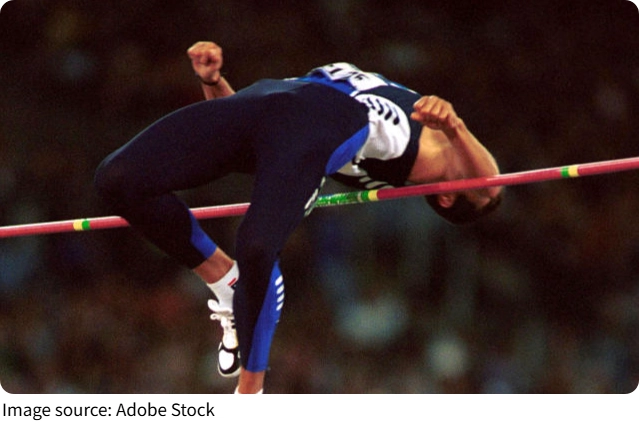High Jump vs. Pole Vault

At first glance, high jump and pole vault might seem similar. Both are thrilling events in track and field, where athletes defy gravity and attempt to clear high beams.
However, the two sports differ significantly in terms of technique, equipment, and how athletes achieve their impressive heights. So, what's the real difference between high jump and pole vault, and what makes each of them so unique?
Let's break it down in a way that makes it easy to understand.
What is High Jump?
In the high jump, the goal is relatively simple: clear a horizontal hurdle that is set at a specific height. Athletes must jump over the hurdle without knocking it down. To do so, they need a combination of speed, strength, and agility, along with a precise jumping technique.
Key Components of High Jump:
1. Takeoff: High jumpers sprint towards the hurdle, building up speed, before planting one foot to launch themselves into the air. The takeoff foot is crucial to achieving the necessary height.
2. Jumping Technique: The jump itself is performed with a technique known as the Fosbury Flop, named after the Olympic gold medalist Fosbury. The athlete arches their back and kicks their legs over the hurdle while keeping their body nearly vertical. This allows for a smoother and safer clearance over the hurdle.
3. Landing: The athlete lands on a cushioned mat after clearing the hurdle. The landing is less risky compared to pole vault, as there's no need for a vaulting pole or the potential for sharp angles of descent.
What is Pole Vault?
The pole vault, on the other hand, is a completely different beast. Instead of just using their body to clear a hurdle, pole vaulters use a long pole (usually made of fiberglass or carbon fiber) to propel themselves over the hurdle. This pole helps them reach much greater heights than they could with a high jump alone.
Key Components of Pole Vault:
1. Pole Planting: The athlete sprints down a runway, similar to the high jump, but with a pole in hand. They plant the pole into a specially designed box in the ground, using the pole's energy to propel themselves upwards.
2. Vaulting Technique: Once the pole is planted, the vaulter uses their body and the pole's bend to rotate over the hurdle. Unlike in high jump, where the body clears the hurdle head-first, pole vaulters often rotate and clear the hurdle upside-down or sideways, depending on the height they are jumping.
3. Landing: After clearing the hurdle, pole vaulters land in a pit filled with foam padding. Due to the pole's arc, the vaulter's descent is steeper than that of a high jumper, making the landing somewhat riskier, though still relatively safe when performed correctly.
Equipment Differences
One of the most obvious differences between these two events is the equipment used. Both sports require specialized gear, but they serve very different purposes.
1. High Jump Equipment:
• Hurdle and Standards: The hurdle is supported by standards, and the athlete must clear it without knocking it off. There is little to no technology involved in high jump equipment; it's all about the athlete's skill and technique.
• Approach Shoes: High jumpers wear lightweight, cushioned shoes that allow for maximum grip and support during their sprint and takeoff. The shoes may also have spikes to enhance traction.
2. Pole Vault Equipment:
• Pole: The most significant piece of equipment in the pole vault is the pole itself, which can be quite long (16 to 17 feet or more) and made of strong, flexible materials such as fiberglass or carbon fiber. The pole's flexibility helps generate upward lift when the vaulter plants it in the box.
• Vaulting Shoes: Pole vaulters also wear specialized shoes with spikes to grip the runway. These shoes are designed for speed and quick acceleration.
Technique: Precision and Control
Both the high jump and pole vault require impeccable technique and coordination, but the way athletes approach each event differs considerably.
1. High Jump Technique:
• High jumpers focus on their run-up, takeoff, and technique for clearing the hurdle. The speed they build up is transferred into height as they launch off their takeoff leg, while their body rotates mid-air to clear the hurdle.
• The main challenge is timing the jump perfectly while maintaining body control and achieving the optimal arc. The athlete's ability to stay focused and execute with precision during their jump often separates the winners from the rest.
2. Pole Vault Technique:
• In pole vault, the technique involves two key phases: the pole planting and the rotation. Vaulters need excellent timing to plant the pole at the right angle and then use the bend in the pole to create the upward force required to clear the hurdle.
• The vaulter's ability to maintain body control throughout the flip over the hurdle is critical. Unlike the high jump, where the athlete's focus is largely on the takeoff and body position, pole vaulters must also be aware of the pole's movements and the required timing of their body's rotation.
Differences in Heights and World Records
Another fascinating aspect of the differences between high jump and pole vault lies in the heights that athletes can achieve. While both events are based on clearing a hurdle, pole vault athletes can generally reach much greater heights than high jumpers.
1. High Jump Records:
• The men's world record for the high jump stands at 2.45 meters (8 feet), set by Javier Sotomayor in 1992.
• The women's record is 2.09 meters (6 feet 10 inches), set by Stefka Kostadinova in 1987.

2. Pole Vault Records:
• The men's world record in pole vault is an astonishing 6.18 meters (20 feet 3.5 inches), set by Armand "Mondo" Duplantis in 2020.
• The women's record is 5.06 meters (16 feet 7 inches), held by Yelena Isinbayeva since 2009.
As you can see, pole vault records far exceed those of high jump, primarily due to the assistance provided by the pole itself. Without the pole, vaulters would not be able to achieve the same heights.
Final Thoughts: The Art of Jumping
While both high jump and pole vault are about defying gravity, they differ in fundamental ways. High jumpers rely solely on their physical strength, technique, and agility, while pole vaulters utilize a pole to assist in reaching much greater heights.
The choice between the two disciplines often comes down to an athlete's preferences, physical abilities, and training. Some may excel in the pure athleticism required for high jump, while others might enjoy the added complexity and challenge of pole vault. Regardless of which event an athlete chooses, both disciplines require incredible skill, strength, and precision—traits that define the thrill of track and field.
-
 Osteoarthritis Alert!Aching Joints Lately? Could It Be More Than Age? Find Out What Hidden Pain Signs Mean!
Osteoarthritis Alert!Aching Joints Lately? Could It Be More Than Age? Find Out What Hidden Pain Signs Mean! -
 50-Kilometer Bike CommuteHow dedicated bike highways and e-bikes are redefining zero-carbon commutes in the Netherlands.
50-Kilometer Bike CommuteHow dedicated bike highways and e-bikes are redefining zero-carbon commutes in the Netherlands. -
 Argentina's GlaciersThis Glacier Trek Feels Unreal—And It's Easier to Plan Than You Think!
Argentina's GlaciersThis Glacier Trek Feels Unreal—And It's Easier to Plan Than You Think!